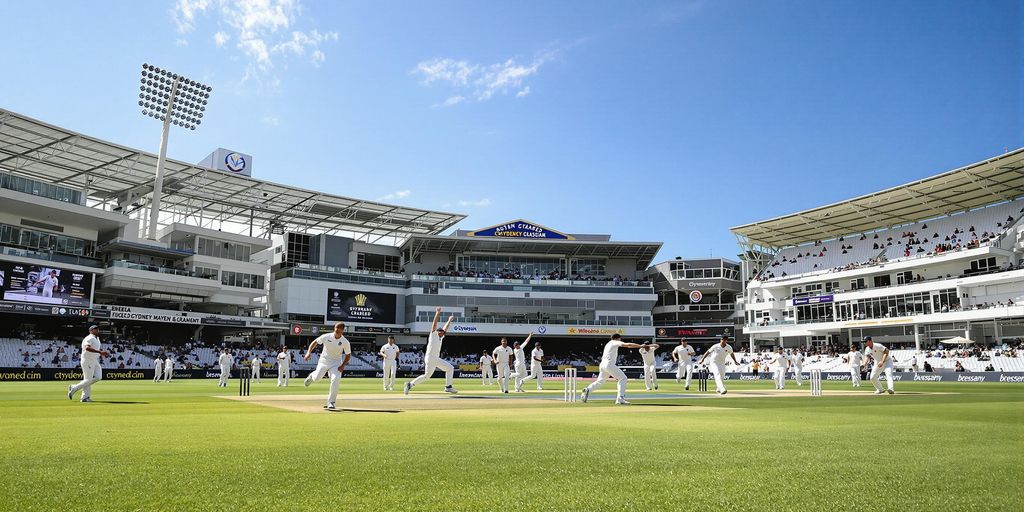Influential Fast Bowlers In Australian Cricket
Mitchell Starc’s Impact on the Game
Mitchell Starc, a name synonymous with raw pace and devastating swing, has undeniably left an indelible mark on Australian cricket. His ability to dismantle batting lineups with sheer speed and late movement makes him a fearsome opponent. Starc’s contributions extend beyond just wickets; his aggressive approach sets the tone for the entire bowling attack. He’s not just a bowler; he’s an intimidator, a game-changer, and a match-winner. His performances in crucial moments, especially in World Cups, cement his place among the greats.
Starc’s impact isn’t just about stats; it’s about the fear he instils in batsmen and the inspiration he provides to young bowlers. He embodies the aggressive spirit of Australian cricket.
Pat Cummins: The Modern-Day Leader
Pat Cummins, the current captain, embodies leadership both on and off the field. His bowling is characterised by relentless accuracy, subtle variations, and an unwavering commitment to the team. He consistently bowls long spells, maintaining pressure and creating opportunities for breakthroughs. Cummins isn’t just a strike bowler; he’s a workhorse, a strategist, and a leader who inspires his teammates to perform at their best. His calm demeanour under pressure and his tactical acumen make him an invaluable asset to the Australian team. He is a true modern-day leader. The Australian system has produced a great leader in Cummins.
Josh Hazlewood’s Consistency and Skill
Josh Hazlewood is the embodiment of consistency and control. His metronomic accuracy and subtle seam movement make him a nightmare for batsmen to face. He consistently hits the right areas, building pressure and creating opportunities for wickets. Hazlewood’s strength lies in his ability to maintain relentless pressure, forcing batsmen into errors. He’s not the fastest bowler, but his control and skill make him incredibly effective.
Here’s a quick look at what makes him so good:
- Unwavering accuracy
- Subtle seam movement
- Relentless pressure
- Consistent line and length
Legendary Spin Bowlers Who Changed The Game
Shane Warne: The Spin Wizard
Warnie, the name says it all, doesn’t it? Shane Warne didn’t just bowl leg spin; he reinvented it. He brought a swagger and a showmanship to the game that hadn’t been seen before. He made spin cool again, especially for us Aussies.
- 708 Test wickets – a record that speaks for itself.
- That Gatting ball in ’93 – pure magic.
- Revived the art of leg-spin when it was almost dying out.
He had this knack for making the impossible seem routine. You’d watch him bowl, and it felt like he was playing chess with the batsman, always one step ahead. It wasn’t just about the wickets; it was about the theatre.
Nathan Lyon’s Test Match Prowess
Lyon, or ‘Garry’ as we affectionately call him, is the quiet achiever. He’s not as flashy as Warne, but he’s just as effective. He’s become an absolute rock in the Aussie team, consistently delivering over after over. He just keeps plugging away, getting the job done.
- Consistent performer in Test cricket for over a decade.
- Over 400 Test wickets and counting.
- Known for his accuracy and ability to bowl long spells.
The Evolution of Spin Bowling in Australia
Spin bowling in Australia has gone through a fair few changes over the years. From the days of Bill O’Reilly to the modern era, it’s been a fascinating journey. It’s not just about having a good spinner; it’s about using them right, at the right time, and in the right conditions.
| Era | Key Characteristics |
|---|---|
| Pre-Warne | Focus on accuracy and control. |
| Warne Era | Aggressive leg-spin, emphasis on attacking batsmen. |
| Post-Warne | A blend of aggression and control, adapting to conditions. |
The Rise of Young Talents in Australian Cricket
It’s no secret that keeping the Aussie cricket team at the top means blooding new talent. We’ve been pretty good at it over the years, but the modern game demands even more focus on identifying and nurturing young blokes and sheilas who can bowl a good ball. The current system isn’t perfect, and there’s a bit of a worry that we’re not giving these kids the best chance to shine.
Brendan Doggett: A Future Star
Brendan Doggett has been on the radar for a while now. He’s got raw pace and aggression, which is exactly what you want to see in a young quick. The big question is whether he can stay fit and consistent enough to make the step up to international cricket. He needs more opportunities in Shield cricket to really hone his skills and learn how to bowl long spells.
Spencer Johnson’s Promising Career
Spencer Johnson is another exciting prospect. He’s got a bit of X-factor about him, and he can swing the ball at a decent pace.
- He’s got a good head on his shoulders.
- He’s willing to learn.
- He seems to thrive under pressure.
Johnson needs to be carefully managed to avoid injuries. Fast bowlers are a precious commodity, and we can’t afford to burn him out before he reaches his full potential.
Lance Morris: The Next Big Thing
Lance Morris is seriously quick. He’s got the kind of pace that can unsettle even the best batsmen.
| Attribute | Description |
|---|---|
| Pace | Consistently bowls above 140km/h |
| Accuracy | Improving, but still needs work |
| Endurance | Needs to build stamina for longer spells |
| Mental Toughness | Shows promise under pressure |
Morris is definitely one to watch, but he needs to keep working hard and developing his game. With the right guidance, he could be a real weapon for Australia in the years to come.
The Role of All-Rounders in Australia’s Bowling Attack
All-rounders are like gold dust in cricket. They bring balance to a team, offering both batting firepower and handy overs with the ball. In Australia, we’ve had some absolute legends who’ve filled this role, and their contributions have been vital to our success.
Shane Watson’s Dual Threat
Shane Watson was a bloke who could change a game with either bat or ball. His aggressive batting at the top of the order, combined with his useful medium-pace bowling, made him a valuable asset in all formats. He wasn’t always the most consistent, but when he was on, he was unstoppable. Remember that spell he had in the Australian Under-19 Cricket Team? Sheer class. He could bowl those nagging lines and lengths, picking up crucial wickets, and then go out and smash the ball to all parts of the ground.
Glenn Maxwell: A Game Changer
Maxwell, or ‘The Big Show’ as he’s often called, is a different kind of all-rounder. He’s more of a batting all-rounder who can bowl some handy off-spin. His ability to clear the ropes with ease makes him a dangerous player in the limited-overs formats. He’s also a gun in the field, which adds another dimension to his game. While he might not be a frontline bowler, his ability to chip in with a few overs and take wickets at crucial times makes him a real game-changer.
The Importance of Versatile Players
Having versatile players in the team is crucial for a few reasons:
- It gives the captain more options when setting fields and rotating bowlers.
- It allows the team to adapt to different conditions and situations.
- It provides depth in both batting and bowling departments.
All-rounders provide flexibility and balance, allowing the team to adjust strategies on the fly. They can fill gaps in the batting order or provide crucial breakthroughs with the ball, making them invaluable assets in any cricket team. Their presence often allows for a more dynamic and adaptable approach to the game.
In the modern game, where adaptability is key, all-rounders are more important than ever. They’re the players who can turn a match on its head and provide that extra edge that can make all the difference. They are a key part of Australia’s bowling attack, providing variety and depth.
Historic Moments in Australian Bowling History

The 2005 Ashes Series
The 2005 Ashes series is etched in cricket folklore, not just for England’s victory, but for the sheer brilliance of bowling on display. While Australia lost, the bowling performances were nothing short of spectacular. Brett Lee, with his raw pace and unwavering aggression, was a constant threat.
The series was a rollercoaster, with momentum swinging wildly. The bowling attacks from both sides were relentless, making every run a hard-fought battle.
Warne’s 700th Wicket
Shane Warne’s achievement of taking his 700th Test wicket was a monumental moment. It wasn’t just a statistical milestone; it was a celebration of a career that redefined spin bowling. Warne’s ability to bamboozle batsmen with his variations and sheer skill was unmatched. The atmosphere at the MCG when he reached the milestone was electric. His Test wickets record speaks for itself.
Cummins’ Match-Winning Performances
Pat Cummins has delivered some incredible match-winning performances. He is a modern-day great. His ability to bowl with pace, accuracy, and intelligence makes him a formidable opponent.
Here are some of his key attributes:
- Relentless aggression
- Exceptional control
- Leadership qualities
Cummins’ performances often come at crucial moments, turning the tide of a match with a single spell. He is a true match-winner.
The Evolution of Australia’s Bowling Strategies
From Pace to Spin: A Tactical Shift
Australian cricket has always been known for its aggressive pace bowling, but there’s been a noticeable shift towards incorporating more spin options. This isn’t just about having a spinner in the team; it’s about strategically using spin to control the game, especially on turning pitches. The tactical shift is evident in how captains now use spinners to build pressure and take wickets in crucial moments. We’ve seen this with the rise of Nathan Lyon, who’s become a mainstay in the Test side, and the increasing importance of part-time spinners in limited-overs cricket.
The Importance of Fitness and Endurance
Modern cricket demands peak physical condition from bowlers. It’s not enough to just bowl fast or spin the ball; bowlers need the endurance to maintain their intensity throughout long spells and the fitness to recover quickly between matches.
Here’s a quick look at the fitness demands:
- Sustained high-intensity bowling
- Quick recovery between spells
- Injury prevention through strength and conditioning
Bowlers are now athletes first and foremost. The focus on fitness has led to longer careers and fewer injuries, allowing them to perform at their best consistently.
Adapting to Different Formats
One of the biggest challenges for Australian bowlers is adapting to the different formats of the game. Test cricket requires patience and consistency, while ODIs and T20s demand aggression and innovation. Bowlers need to develop a range of skills and strategies to succeed in all three formats. cricket’s technical development is key to this adaptation.
Consider these points:
- Varying pace and length in Tests
- Developing slower balls and variations for ODIs
- Mastering yorkers and slower bouncers for T20s
The Impact of Domestic Competitions on Bowlers

Sheffield Shield: A Crucible for Talent
The Sheffield Shield is the proving ground for Aussie cricketers. It’s where players either sink or swim, and it’s been that way for yonks. The Shield gives young blokes the chance to bowl long spells, learn to build pressure, and figure out how to get top-order batsmen out on different kinds of pitches. It’s not just about raw talent; it’s about developing the grit and smarts needed for Test cricket.
The Shield is more than just a competition; it’s a finishing school for Test cricketers. It teaches patience, resilience, and the ability to perform under pressure – qualities that are often missing in players who come through the ranks too quickly.
BBL’s Influence on Fast Bowlers
The Big Bash League (BBL) has changed the game, no doubt. It’s brought in crowds and cash, but it’s also had some unintended consequences, especially for fast bowlers. Instead of bowling 20 overs in a day, they’re often limited to four-over spells. This is great for T20 skills, but not so good for building the stamina needed for Test matches.
Here’s a quick look at the typical bowler’s workload:
| Format | Overs per Match | Focus |
|---|---|---|
| Sheffield Shield | 15-25+ | Endurance, consistency |
| BBL | 4 | Impact, variations |
The Pathway to International Cricket
The pathway to the Aussie Test team used to be pretty clear: dominate grade cricket, shine in the Sheffield Shield, and then get a call-up. These days, it’s a bit more complicated. The BBL has created another route, but it’s not always the best one for developing Test cricketers. We need to make sure that young bowlers get enough exposure to long-form cricket if they’re going to be ready for the challenges of the international game.
Here are some things that could help:
- More Shield matches.
- A stronger focus on red-ball skills in development programmes.
- Opportunities for young players to play against international opposition in longer formats.
Challenges Facing Australia’s Bowling Future
Development of Young Bowlers
Mate, the biggest worry is how we’re bringing up the next crop of bowlers. They just aren’t getting the solid grounding they need to cut it at the highest level, especially in Test cricket. It’s like they’re learning to sprint before they can walk. The old system, where blokes could spend a full season in the Sheffield Shield, building up their stamina and skill, is pretty much gone. Now, it’s all about short bursts and T20 glory, which doesn’t exactly prepare you for bowling 25 overs on a hot day in Brisbane. We need to look at how we can get these young fellas more exposure to long-form cricket, so they’re ready when their chance comes.
- More Shield cricket exposure
- Mentorship programmes with past greats
- Specialised training camps focusing on endurance
Balancing Formats and Player Workload
It’s a tough gig these days, juggling all the different formats. You’ve got Test cricket, ODIs, T20s, and the BBL all vying for attention, and it’s taking a toll on the players. Fast bowlers, in particular, are feeling the pinch. They’re expected to bowl flat out in every game, no matter the format, and it’s leading to injuries and burnout. We need to be smarter about managing their workload, so they’re fresh and firing when it matters most. Maybe that means resting them from certain games or even entire series. It’s a short-term sacrifice for long-term gain.
The current system is a bit of a mess, to be honest. The BBL is great for entertainment, but it clashes with the Sheffield Shield, disrupting the flow of the season and preventing young players from building momentum. It’s like trying to build a house on shifting sands. We need to restructure the calendar so that first-class cricket gets the priority it deserves.
The Need for Systemic Changes
Look, the truth is, the whole system needs a good hard look. We can’t just keep doing the same thing and expect different results. Cricket Australia needs to be bold and make some radical changes to the way we develop and manage our bowlers. That might mean restructuring the domestic competitions, investing more in youth development programmes, or even changing the way we select our national teams. Whatever it takes, we need to act now before we fall behind the rest of the world. Countries like India and England are investing heavily in their cricket infrastructure, and we can’t afford to be complacent. The Australia T20 squad needs to be supported by a strong domestic system.
| Area | Current State | Proposed Change | Benefit |
|---|---|---|---|
| Domestic Comp | BBL clashes with Sheffield Shield | Separate seasons for BBL and Shield | Allows players to focus on one format at a time, improving skill development |
| Youth Dev | Limited investment in grassroots programmes | Increased funding for youth academies | Provides more opportunities for young players to develop their skills |
| Player Mgmt | Overworked fast bowlers | Rotation policy and workload monitoring | Reduces the risk of injury and burnout |
Iconic Bowling Partnerships in Australian Cricket
Australian cricket’s history is littered with amazing bowling partnerships. It’s not just about individual brilliance, but how two bowlers can work together, complement each other, and create sustained pressure on the opposition. These partnerships become the stuff of legend, remembered for their impact on games and their ability to inspire future generations.
Warne and McGrath: A Legendary Duo
Without a doubt, the pairing of Shane Warne and Glenn McGrath stands out as the most iconic. Their combined skill, consistency, and tactical awareness were unmatched. McGrath’s relentless accuracy and Warne’s magical spin created a web that batsmen simply couldn’t escape. They hunted in pairs, one applying the pressure, the other taking the wickets. Their partnership wasn’t just about taking wickets; it was about controlling the game and dictating terms to the opposition. They are the gold standard for bowling partnerships.
The Current Trio: Starc, Cummins, Hazlewood
In the modern era, the trio of Mitchell Starc, Pat Cummins, and Josh Hazlewood have emerged as a dominant force. Each brings a unique skill set to the attack. Starc’s express pace, Cummins’ leadership and all-round ability, and Hazlewood’s metronomic accuracy make them a formidable combination. They’ve shown great resilience and have been instrumental in Australia’s success across all formats. They are all entering the twilight of their careers, so it’s important to consider who will be the worthy successors.
Historic Partnerships That Shaped Matches
Beyond the famous names, there are other partnerships that deserve recognition. Think back to the days of Lillee and Thomson, terrorising batsmen with sheer pace. Or the spin wizardry of O’Reilly and Grimmett, bamboozling opponents with their variations. These partnerships weren’t just about individual brilliance; they were about creating a combined force that was greater than the sum of its parts. They shaped the course of matches and left a lasting impact on Australian cricket.
These partnerships highlight the importance of having bowlers who can work together, understand each other’s strengths, and execute plans effectively. It’s a reminder that cricket is a team sport, and even the most talented individual bowler needs a partner to create sustained pressure and take wickets.
Here are some key elements of successful bowling partnerships:
- Complementary skills
- Tactical awareness
- Consistent pressure
The Legacy of Australia’s Greatest Bowlers
Warne’s Lasting Influence on Spin
Warnie, the Spin Wizard, didn’t just take wickets; he reinvented leg spin. He made it exciting again, capturing the imagination of fans worldwide. His impact goes beyond the Test wickets he snared; he inspired a generation of leggies and changed how cricket viewed spin bowling. He showed that spin could be aggressive, attacking, and utterly dominant.
The Records of Australia’s Fast Bowling Greats
Australia’s fast bowling history is filled with legends. From Dennis Lillee’s raw aggression to Glenn McGrath’s metronomic accuracy, these blokes set the standard. Their records speak for themselves, but it’s their impact on the game that truly defines their legacy. They weren’t just about pace; they were about skill, strategy, and relentless pressure.
- Dennis Lillee: A fearsome presence who terrorised batsmen.
- Glenn McGrath: The epitome of accuracy and consistency.
- Brett Lee: Blistering pace and infectious energy.
How Past Legends Inspire Future Generations
Those who came before set the bar high, and the current crop of Aussie bowlers know it. They grew up watching Warne bamboozle batsmen and McGrath relentlessly hit the seam. That’s the kind of stuff that sticks with you.
The pressure to live up to the legends is immense, but it’s also a source of motivation. Young bowlers dream of emulating their heroes, pushing themselves to reach new heights and continue Australia’s proud bowling tradition.
The Future of Australia’s Bowling Line-Up
Emerging Bowlers to Watch
Alright, so, who’s next in line to chuck down some thunderbolts for Australia? It’s a question on every cricket fan’s lips, especially with the current legends getting on a bit. We’ve got a few names buzzing around the traps. Guys like Brendan Doggett have shown glimpses of brilliance in the Sheffield Shield, proving they can handle the pressure. Then there’s Spencer Johnson, who’s got that raw pace that can unsettle any batsman. And let’s not forget Lance Morris – the bloke can seriously bowl. These fellas need consistent game time and proper guidance to really blossom, but the potential is definitely there.
The Importance of Youth Development
Look, if we want to stay on top, we need to invest in the young blokes. It’s as simple as that. The current system isn’t exactly helping them, with the BBL interrupting the Shield season and all. They’re bowling four-over spells instead of building up the fitness and endurance needed for Test cricket. We need to restructure the calendar so these young guns get a proper crack at long-form cricket. More opportunities, more A-team matches, and better coaching – that’s the recipe for success. If we don’t, we risk falling behind other countries who are taking youth development seriously.
Strategic Planning for Upcoming Tours
Planning for the future isn’t just about finding the next big thing; it’s about managing the resources we have. We need to think about workload management, especially with the amount of cricket being played these days. Rotating bowlers, giving them breaks when needed, and making sure they’re in peak condition for important tours – that’s the key. And it’s not just about the quicks; we need to nurture our spinners too. Different conditions require different strategies, and having a diverse bowling attack is crucial for long-term success.
The success of Australian cricket hinges on the development of young players. Declining performances would keep crowds away, erode media rights value, reduce funding for grassroots programmes, and ultimately threaten jobs across the sport.
Here’s a few things we need to focus on:
- Restructuring the cricket calendar to prioritise long-form cricket.
- Expanding opportunities for young players through A-team matches.
- Investing in coaching and development programmes.
Wrapping It Up
So, there you have it. Australia’s bowling legends have left a mark that’s hard to forget. From the fiery pace of Mitchell Starc to the crafty spin of Shane Warne, these players have shaped the game and inspired countless fans. But it’s not just about the past; the future is looking a bit shaky. We need to get back to nurturing young talent and giving them the right chances to shine. If we don’t, we might find ourselves struggling to keep up with the rest of the world. Let’s hope the next generation can rise to the occasion and keep Australia’s cricketing legacy alive.




